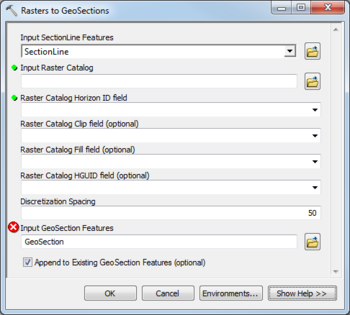AHGW:Rasters to GeoSections: Difference between revisions
From XMS Wiki
Jump to navigationJump to search
(Created page with "350px|thumb|right|''Rasters to GeoSections'' dialog The ''Rasters to GeoSections'' tool is accessed by d...") |
m (Move page script moved page AHGW:Rasters to GeoSections to Test:Rasters to GeoSections without leaving a redirect) |
(No difference)
| |
Revision as of 23:41, 9 September 2019
The Rasters to GeoSections tool is accessed by double-clicking on "![]() Rasters to GeoSections" under the "
Rasters to GeoSections" under the "![]() Features" toolset under the "
Features" toolset under the "![]() Subsurface Analyst" toolset under the "
Subsurface Analyst" toolset under the "![]() Arc Hydro Groundwater Tools" toolbox. This tool creates new GeoSection features from sectioin lines and a raster catalog representing a depositional sequence.
Arc Hydro Groundwater Tools" toolbox. This tool creates new GeoSection features from sectioin lines and a raster catalog representing a depositional sequence.
The following fields are available. Required fields are marked with a ![]() icon. Fields marked with a
icon. Fields marked with a ![]() icon may either not be supported or the table doesn't exist.
icon may either not be supported or the table doesn't exist.
- Input SectionLine Features – Click the
 button to bring up the Input SectionLine Features dialog in order to specify the polyline features used to define the location of the GeoSection features to be created.
button to bring up the Input SectionLine Features dialog in order to specify the polyline features used to define the location of the GeoSection features to be created.  Input Raster Catalog – Click the
Input Raster Catalog – Click the  button to bring up the Input Raster Catalog dialog in order to specify the raster catalog containing rasters for each horizon.
button to bring up the Input Raster Catalog dialog in order to specify the raster catalog containing rasters for each horizon. Raster Catalog Horizon ID Field – Select from the drop-down the field in the raster catalog containing the horizon ID of the rasters. Each horizon ID should be unique.
Raster Catalog Horizon ID Field – Select from the drop-down the field in the raster catalog containing the horizon ID of the rasters. Each horizon ID should be unique.- Raster Catalog Clip Field – Optional. Select from the drop-down the field in the Raster Catalog used to specify certain rasters as clipping planes. If a raster is specified as a clipping plane, then elevation values on horizons below that raster will be clipped to the raster if they are greater than the clipping raster. The Clip field should contain one of the following values:
- "0" – The raster is not used for clipping (default value).
- "1" – The raster is used for clipping horizons below it.
- Raster Catalog Fill Field – Optional. Select from the drop-down the field in the Raster Catalog used to specify how the horizons are built between Horizon IDs. The Fill field should contain the following values:
- "0" – Do not fill between a lower HorizonID and a higher one.
- "1" – Fill between a lower HorizonID and a higher one (default value).
- Raster Catalog HGUID Field – Optional. Select from the drop-down the field in the raster catalog containing the Hydrogeologic Unit identifier, as part of the Arc Hydro Groundwater Data Model.
- Discretization Spacing – Enter the spacing or interval at which values are read from the raster, which determines the number of triangle strips used to create the multipatch GeoSection features. The smaller the value, the longer the tool will take to execute. The spacing value is in the same units as that of the SectionLine features.
- Input GeoSection Features – Click the
 button to bring up the Input GeoSection Features dialog in order to specify the multipatch GeoSection feature class where new features will be created.
button to bring up the Input GeoSection Features dialog in order to specify the multipatch GeoSection feature class where new features will be created. - Append to Existing GeoSection Features – Turn on to append new GeoSections to the feature class. Turn off to clear the target feature class prior to creating new GeoSections.

